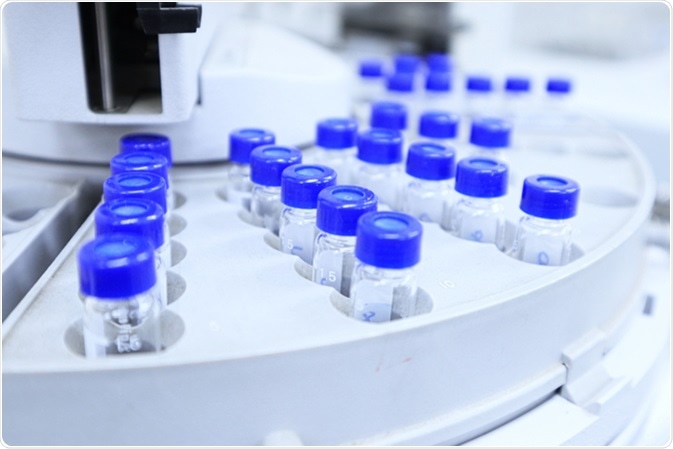Liquid chromatography-mass spectrometry (LC-MS) is a technique used in analytical chemistry that combines the two analytical techniques of high-capacity separation with liquid chromatography (LC) and the high-sensitivity detection of mass spectrometry (MS).

Samples in gas chromatography analysis in the laboratory. Image Credit: Hotsum / Shutterstock
LC separates the components of a mixture based on their affinity to a stationary or mobile phase and subsequently detects these components using ultraviolet light, fluorescence, or electrical conductivity, which can all affect the analysed substances.
The basis of MS is the separation of ionised components in a vacuum according to their mass-to-charge ratio. Component concentrations are quantitatively analysed according to the intensity of the measured peaks.
The ability to quantify concentrations of ions of mass is limited to solutions of single components, as multiple component analysis yields spectra that are complex and difficult to analyse. Consequently, LC-MS combines the separation resolution of LC with the qualitative capabilities of MS.
MS techniques enable the molecular mass and structural characteristics of eluted components to be determined. This process complements the qualitative data obtained from the retention times recorded by LC. The quality of data derived from MS can be enhanced by imposing a parameter called selected ion monitoring (SIM), which is highly sensitive and allows quantitative analysis that circumvents effects of impurities that fail to be removed by LC.
Mass spectrometry has been the detection technique of choice for pharmaceutical analysis for many years. It is a powerful means of analysis that allows complex pharmacological mixtures to be separated into their constituent components. In addition, LC-MS is a sensitive, well-understood and highly reproducible technique.
LC-MS is used to analyse pharmaceuticals across a variety of stages in their discovery and development. These stages include drug discovery, metabolism studies (in vitro and in vivo), and identification of impurities and degradation products. The process of drug discovery usually begins with the isolation and characterisation of potential drug substances that originate from synthetic or natural compounds.
LC-MS in drug metabolism studies
Before a compound can be developed into a drug, it must be studied extensively to determine its potential therapeutic value. An attractive candidate should be metabolically stable and possess a good pharmacokinetic profile.
Pharmacokinetics describes how the body affects drug absorption, distribution, metabolism, and excretion. Furthermore, the drug should demonstrate good bioavailability, which is defined as the quantity of administered drug that reaches the circulation and persists there for a satisfactory period during which it can produce the desired action. This latter characteristic is called a half-life.
An active metabolite is formed from the compound after the candidate is metabolised by the body. The metabolite(s) may be more pharmacokinetically active than the ‘parent’ candidate drug (from which the candidate is derived). Therefore, correct characterisation of the major and minor metabolites aids in the identification of drugs with improved metabolic stability, pharmacological activity and stability. This analysis also ensures that the toxicology profile of the drug is improved, ensuring drug safety.
In Vitro drug metabolism
This branch of study is concerned with analysing the effects of a drug on organs outside the body. The liver is the organ primarily responsible for drug metabolism. For this reason, liver microsomal preparations or hepatocytes are used as the tissue for in vitro testing and provide an indication of the metabolic outcomes of a drug.
3-hydroxytamoxifen is a drug derived from tamoxifen, an anti-breast cancer agent, that is used to demonstrate the application of LC-MS in drug metabolism. 3- hydroxytamoxifen tested on human liver microsomes is an example of in vitro metabolism study.
In 2002, Chang-Kee and Gwyn identified the metabolites desmethyldroloxifene, 4-hydroxydroloxifene, droloxifene N-oxide, and a-hydroxydroloxifene. The latter three metabolites had identical mass-to-charge ratios of 404. Chromatographic resolution (the LC of LC-MS) was paramount in this case to differentiate between compounds.
In Vivo Drug Metabolism
In vivo metabolism studies involve monitoring drug discovery in the body with a focus on drugs and metabolites in blood, urine, and faeces.
Samples taken from these sources contain endogenous compounds that have the potential to compromise the resolution obtained by LC-MS. It is, therefore, necessary to implement a good sample preparation technique and chromatographic separation is required to successfully apply LC-MS. This is exemplified by the in vivo analysis of 3-hydroxytamoxifen and its metabolites from the plasma of breast milk taken from a breast cancer patient.
In another experiment by Chang-Kee and Gwyn (2002), three peaks were discovered at m/z 388. These were characterised as 4-hydroxytamoxifen, 4’-hydroxytamoxifen, and tamoxifen N-oxide based on MS. Further MS study called tandem MS/MS was used to identify peaks caused by an endogenous plasma component unrelated to tamoxifen and the metabolite N-desdimethyltamoxifen. This experiment demonstrates the limitation of using LC-MS alone without MS/MS.
Identification of impurities and degradation products
The identification of impurities and degradation products is important to ensure that observed pharmacological and toxicological effects are due to the drug rather than impurities. Analysis of the impurities and products of degradation is essential in preventing the production of harmful compounds during the drug’s shelf-life.
Knowledge of degradation products augments the understanding of side-effects that may arise and enables synthesis of new, more stable drugs. Impurities in drugs are predominantly formed during the synthesis of drugs from raw materials. Similarly, by-products may arise during the synthetic process.
The mixture yielded by the synthetic process, therefore, contains varied concentrations of compounds; thus, sensitive and specific detection is necessary to ensure their removal. It is for this reason that LC-MS is widely implemented in this process.
Further Reading